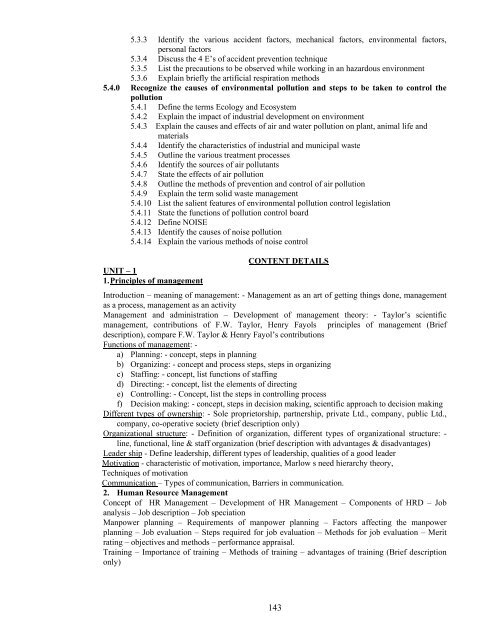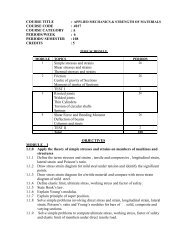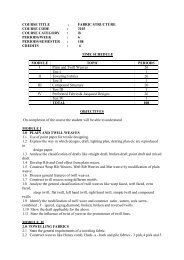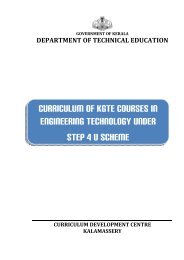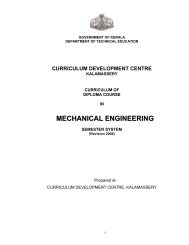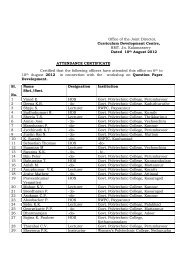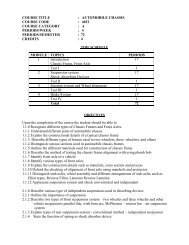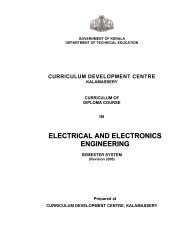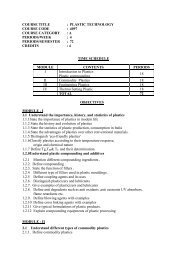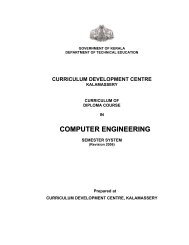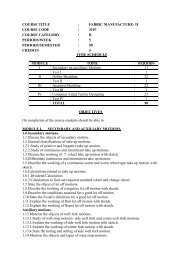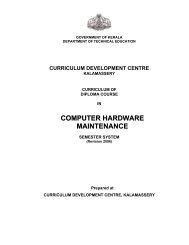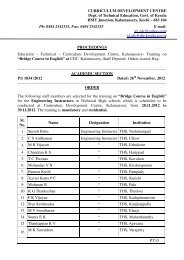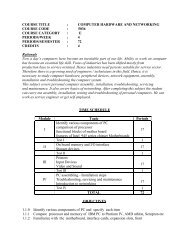23 - Curriculum Development Centre, Kalamassery
23 - Curriculum Development Centre, Kalamassery
23 - Curriculum Development Centre, Kalamassery
You also want an ePaper? Increase the reach of your titles
YUMPU automatically turns print PDFs into web optimized ePapers that Google loves.
5.3.3 Identify the various accident factors, mechanical factors, environmental factors,personal factors5.3.4 Discuss the 4 E’s of accident prevention technique5.3.5 List the precautions to be observed while working in an hazardous environment5.3.6 Explain briefly the artificial respiration methods5.4.0 Recognize the causes of environmental pollution and steps to be taken to control thepollution5.4.1 Define the terms Ecology and Ecosystem5.4.2 Explain the impact of industrial development on environment5.4.3 Explain the causes and effects of air and water pollution on plant, animal life andmaterials5.4.4 Identify the characteristics of industrial and municipal waste5.4.5 Outline the various treatment processes5.4.6 Identify the sources of air pollutants5.4.7 State the effects of air pollution5.4.8 Outline the methods of prevention and control of air pollution5.4.9 Explain the term solid waste management5.4.10 List the salient features of environmental pollution control legislation5.4.11 State the functions of pollution control board5.4.12 Define NOISE5.4.13 Identify the causes of noise pollution5.4.14 Explain the various methods of noise controlUNIT – 11. Principles of managementCONTENT DETAILSIntroduction – meaning of management: - Management as an art of getting things done, managementas a process, management as an activityManagement and administration – <strong>Development</strong> of management theory: - Taylor’s scientificmanagement, contributions of F.W. Taylor, Henry Fayols principles of management (Briefdescription), compare F.W. Taylor & Henry Fayol’s contributionsFunctions of management: -a) Planning: - concept, steps in planningb) Organizing: - concept and process steps, steps in organizingc) Staffing: - concept, list functions of staffingd) Directing: - concept, list the elements of directinge) Controlling: - Concept, list the steps in controlling processf) Decision making: - concept, steps in decision making, scientific approach to decision makingDifferent types of ownership: - Sole proprietorship, partnership, private Ltd., company, public Ltd.,company, co-operative society (brief description only)Organizational structure: - Definition of organization, different types of organizational structure: -line, functional, line & staff organization (brief description with advantages & disadvantages)Leader ship - Define leadership, different types of leadership, qualities of a good leaderMotivation - characteristic of motivation, importance, Marlow s need hierarchy theory,Techniques of motivationCommunication – Types of communication, Barriers in communication.2. Human Resource ManagementConcept of HR Management – <strong>Development</strong> of HR Management – Components of HRD – Jobanalysis – Job description – Job speciationManpower planning – Requirements of manpower planning – Factors affecting the manpowerplanning – Job evaluation – Steps required for job evaluation – Methods for job evaluation – Meritrating – objectives and methods – performance appraisal.Training – Importance of training – Methods of training – advantages of training (Brief descriptiononly)143


